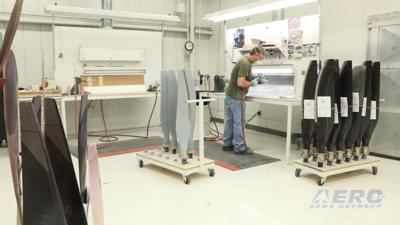Tue, Jan 18, 2022
Carbon Fiber, Glass-Impregnated Composites Leading the Pack For Component Popularity
Forecasted manufacturing component needs throughout the aerospace and defense industry are looking up, according to a recently released report analyzing the composites market through 2029.

As technology has improved, manufacturers have increasingly leaned into alternative materials for aircraft components, owing to a series of benefits ranging from decreased thrust requirements, reduced fuel consumption, and reduced carbon emissions. Use of fiber-impregnated polymers, carbon fiber, and other thermoset composites are quickly biting off a bigger piece of the market from traditional aluminum and steel for new production aircraft. The overall market for aerospace composites reached $20.13 billion, and is forecasted to grow by an average of 8.06% annually to eventually reach $46.47 billion in all. North America has assumed roughly 40% of the overall market revenue throughout a series of OEMs. Commercial aviation is responsible for more than 60% of the continent's aviation sector, with the remainder segmented between defense aviation, UAVs, soldier protection systems, armored vehicles. UAVs are expected to grow fastest out of the group, with an average growth rate of 12.36% overall.

In all, the largest composite market segment lies in carbon fiber reinforced composites, with similar glass fiber composites trailing behind. New developments in large-scale additive manufacturing (industrial scale 3d printing) are expected to lead to steady growth as the techniques are filtered down across the industry. Unpredictable catalytic effects of synergistic interactions between IT-based technology and advancements in manufacturing could show sharp increases in efficiency, as seen to an extent between computerized rapid prototyping and printable components in turbine engine design. Reduced numbers of components in the next generation of turbine engines can enhance reliability, simplify production, and increase efficiency all at once.
More News
Aero Linx: Model Aeronautical Association of Australia MAAA clubs are about fun flying, camaraderie and community. For over 75 years, the MAAA has been Australia’s largest fl>[...]
Touchdown Zone Lighting Two rows of transverse light bars located symmetrically about the runway centerline normally at 100 foot intervals. The basic system extends 3,000 feet alon>[...]
“Discovery and innovation are central to our mission at Virgin Galactic. We’re excited to build on our successful record of facilitating scientific experiments in subor>[...]
How To Get A Story On Aero-TV News/Feature Programming How do I submit a story idea or lead to Aero-TV? If you would like to submit a story idea or lead, please contact Jim Campbel>[...]
Student Pilot Reported That During Rotation, “All Of A Sudden The Back Of The Plane Kicked To The Right..." Analysis: The student pilot reported that during rotation, “>[...]
 ANN's Daily Aero-Linx (05.02.24)
ANN's Daily Aero-Linx (05.02.24) ANN's Daily Aero-Term (05.02.24): Touchdown Zone Lighting
ANN's Daily Aero-Term (05.02.24): Touchdown Zone Lighting Aero-News: Quote of the Day (05.02.24)
Aero-News: Quote of the Day (05.02.24) ANN FAQ: Contributing To Aero-TV
ANN FAQ: Contributing To Aero-TV NTSB Final Report: Cirrus Design Corp SR20
NTSB Final Report: Cirrus Design Corp SR20




